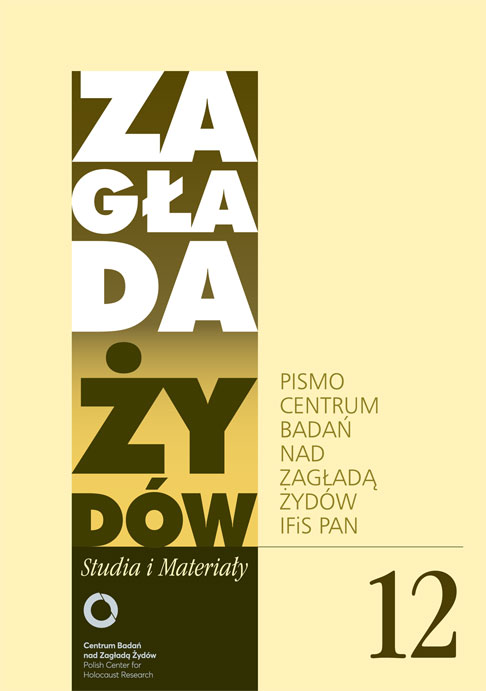Zagłada jako horror. Kilka uwag o literaturze polskiej 1985–2015
Zagłada Żydów. Studia i Materiały, Nr 12 (2016), Strony: 375-394
Data zgłoszenia: 2020-10-20Data publikacji: 2016-11-30
 https://doi.org/10.32927/ZZSiM.423
https://doi.org/10.32927/ZZSiM.423
Abstrakt
The author suggests that the depictions of the Holocaust in Polish literature of 1918–2014 should be categorized as horror. From the chronological perspective, Czapliński divides those thirty years into three shorter periods: 1) the initial period (from Claude Lanzmann’s Shoah and Jan Błoński’s essay “The Poor Poles Look at the Ghetto” to Wilhelm Dichter’s and Michał Głowiński’s memoirs) was dominated by white horror, which presented Jews as ghosts demanding a place in the Polish memory; 2) during the second period (from Marek Bieńczyk’s Tworki and Jan Tomasz Gross’ Neighbors until the end of the 2010s) the horror poetics was used to reveal those principles of pre-war and occupation-period normality which helped the Germans conduct the Holocaust and which conditioned the exclusion of Jews from the Polish circle of ‘normal humanity’; 3) during the third period (from Gross’s Golden Harvest until now) Jews return as the undead, violating the rules of distance and obliging Poles to physically touch the disgusting topic of the Holocaust. The contact with the Holocaust as something abhorring becomes a condition for self-knowledge, purging, and establishment of a new imaginary community.
Słowa kluczowe
Zagłada , horror , groza , obrzydliwość
Licencja
Prawa autorskie (c) 2016 Autor&"Zagłada Żydów. Studia i Materiały"

Utwór dostępny jest na licencji Creative Commons Uznanie autorstwa 4.0 Międzynarodowe.
https://creativecommons.org/licenses/by/4.0
Czasopismo publikowane jest w standardzie Diamond Open Access na licencji CC-BY-4.0 Deed - Uznanie autorstwa 4.0 Międzynarodowa - Creative Commons
Inne teksty tego samego autora
- Przemysław Czapliński, The Auschwitz Virus , Zagłada Żydów. Studia i Materiały: Nr Holocaust Studies and Materials (2017)
- Przemysław Czapliński, Prawda i co dalej , Zagłada Żydów. Studia i Materiały: Nr 15 (2019)
- Przemysław Czapliński, Wirus Auschwitz , Zagłada Żydów. Studia i Materiały: Nr 10 (2014)
Podobne artykuły
- Agnieszka Haska, Keep calm and bądź jak Jan Karski , Zagłada Żydów. Studia i Materiały: Nr 11 (2015)
- Marta Tomczok, Kinga Piotrowiak-Junkiert, Świadomość zwrócona przeciwko sobie samej. Imre Kertész wobec Zagłady , Zagłada Żydów. Studia i Materiały: Nr 12 (2016)
- Jacek Leociak, On the Abuses in Research of the Holocaust Experience , Zagłada Żydów. Studia i Materiały: 2010: Holocaust Studies and Materials
- Jurij Radczenko, „Niemcy znaleźli u nich zrabowane żydowskie rzeczy i dlatego ich rozstrzelali”: Kureń Bukowiński, Holokaust w Kijowie i świadectwo Marty Zybaczynskiej , Zagłada Żydów. Studia i Materiały: Nr 14 (2018)
- Kinga Piotrkowiak-Junkiert, Stan badań nad Zagładą na Węgrzech , Zagłada Żydów. Studia i Materiały: Nr 12 (2016)
- Nawojka Cieślińska-Lobkowicz, O wystawie „Czego nie mogliśmy wykrzyczeć światu” w Żydowskim Instytucie Historycznym w Warszawie , Zagłada Żydów. Studia i Materiały: Nr 14 (2018)
- Kaja Kaźmierska, Krzysztof Malicki, Poza wspólnotą pamięci. Życie i zagłada Żydów w pamięci mieszkańców rejonu podkarpackiego, Warszawa: Wydawnictwo Instytutu Filozoϐii i Socjologii PAN, 2017, 363 s. , Zagłada Żydów. Studia i Materiały: Nr 14 (2018)
- Piotr Litka, Zdzisław Lorek, Grzegorz Pawlikowski, Śledztwo sędziego Władysława Bednarza w sprawie niemieckiego obozu zagłady Kulmhof , Zagłada Żydów. Studia i Materiały: Nr 14 (2018)
- Barbara Krawcowicz, Teodycea w czasie Zagłady. Wojenne kazania rabina Szlomy Zalmana Unsdorfera , Zagłada Żydów. Studia i Materiały: Nr 15 (2019)
- Carson Phillips, Szanse, wyzwania i interpretacje: nauczanie o Holokauście w Kanadzie , Zagłada Żydów. Studia i Materiały: Nr 11 (2015)
<< < 1 2 3 4 5 6 7 8 9 10 11 12 13 14 15 16 17 18 19 20 21 22 23 24 25 26 27 28 29 30 31 32 33 34 35 36 37 38 39 40 41 42 43 44 > >>
Możesz również Rozpocznij zaawansowane wyszukiwanie podobieństw dla tego artykułu.
 English
English
 Język Polski
Język Polski



 https://orcid.org/0000-0002-4805-6471
https://orcid.org/0000-0002-4805-6471





